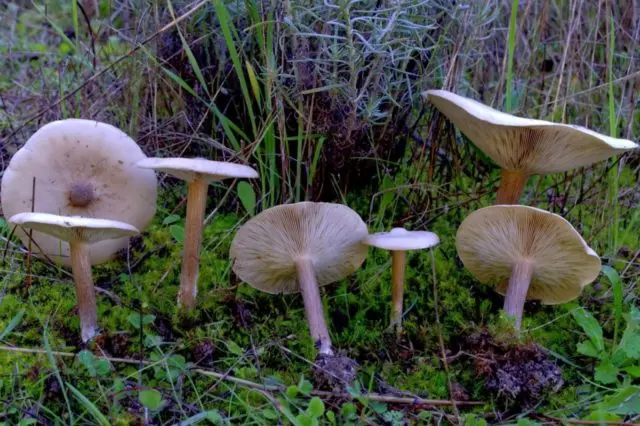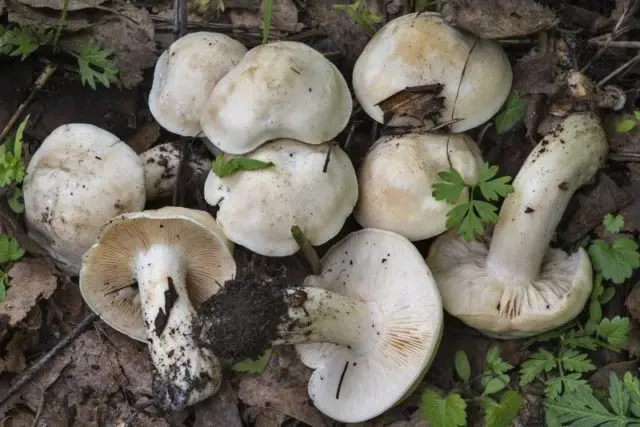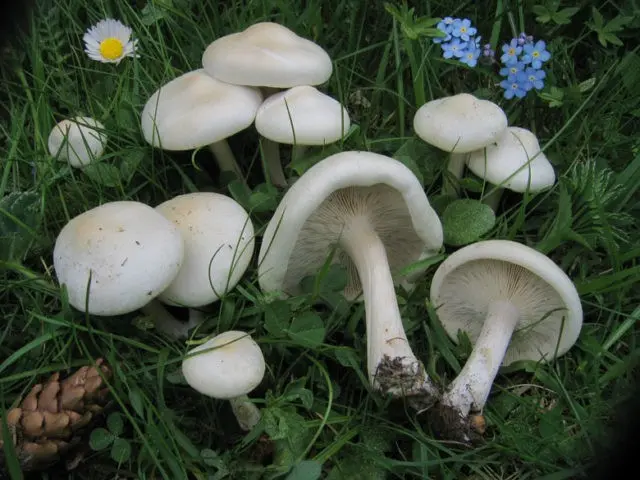Contents
Melanoleuca striated leg is a member of the Ryadovkovye family. It grows in small groups and singly everywhere on all continents. It is found in scientific reference books as Melanoleuca grammopodia.
What do melanoleuks look like?
This species is characterized by the classical structure of the fruiting body, so it has a pronounced hat and leg.
The diameter of the upper part in adult specimens reaches 15 cm. Initially, the cap is convex, but as it grows, it flattens and becomes slightly concave. A tubercle appears in the center over time. The edge of the cap is curved, not wrapped. The surface is dry matte even at high air humidity. The shade of the upper part can be gray-white, ocher or light hazel, depending on the place of growth. Overripe specimens lose color saturation and become faded.
The flesh of the fruiting body is initially white-gray, and later becomes brown. Upon contact with air, its shade does not change. The consistency is elastic regardless of the age of the fungus.

The pulp of melanoleuca stripe-legged has an inexpressive mealy smell and a sweetish taste.
This species has a lamellar hymenophore. Its color is initially grey-white, turning brown as the spore matures. The plates are often sinuous, and in some cases they can be serrated and adhere to the stem.
The lower part is cylindrical, slightly thickened at the base. Its length reaches 10 cm, and the width varies between 1,5-2 cm. On the surface, you can see longitudinal dark brown fibers, due to which the pulp is characterized by increased rigidity. The cover is missing. Spore powder is white or light cream. In melanoleuca, the stripe-legged spores are thin-walled, 6,5-8,5 × 5-6 microns in size. Their shape is ovoid, on the surface there are large, medium and small warts.
Where do melanoleucs grow
This species can be found anywhere in the world. Melanoleuca stripe-legged prefers to grow in deciduous forests and mixed plantings, sometimes can be found in conifers. Mostly grows in small groups, occasionally singly.
Melanoleuca striate leg can also be found:
- in gardens;
- in a meadow;
- in the park area;
- in light grassy areas.
Is it possible to eat melanoleuks striped leg
This species belongs to the category of edible. In terms of taste, it belongs to the fourth class. Only the cap can be eaten, because due to the fibrous consistency, the leg is characterized by increased rigidity.
False doubles
According to external signs, the melanoleuca striate is similar to other species. Therefore, you should familiarize yourself with the main differences between twins in order to avoid mistakes.
May mushroom. An edible member of the lyophyllic family. The hat is hemispherical or cushion-shaped with respect to the correct shape. The diameter of the upper part reaches 4-10 cm. The leg is thick and short. Its length is 4-7 cm, and its width is about 3 cm. The surface color is cream, and closer to the center of the cap it is yellowish. The pulp is white dense. Grows in groups. The official name is Calocybe gambosa. It is possible to confuse it with melanoleukic stripe-legged only at the initial stage of growth. The fruiting period begins in May-June.

With a large crowding, the cap of the May mushroom is deformed
Melanoleuca straight-legged. This species is considered edible, belongs to the Ryadovkovye family. This twin is a close relative of the melanoleuca striatopodia. The color of the fruit body is cream, only towards the center of the cap the shade is darker. The diameter of the upper part is 6-10 cm, the height of the leg is 8-12 cm. The official name is Melanoleuca strictipes.

Melanoleuca straight-legged grows mainly in pastures, meadows, and gardens.
Collection rules
In warm weather in spring, melanoleuca can be found in April, but the massive fruiting period begins in May. There were also recorded cases of collecting single specimens in spruce forests in July-August.
When harvesting it is necessary to use a sharp knife, cutting off the mushroom at the base. This will prevent damage to the integrity of the mycelium.
Use
Melanoleuca striate can be eaten without fear, even fresh. During processing, the mealy smell of the pulp disappears.
Also, melanoleuca can be combined with other mushrooms to prepare different dishes.
Conclusion
Melanoleuca striated leg is a worthy representative of its family. With proper preparation, it can compete with other common types. In addition, its fruiting falls in the spring, which is also an advantage, since the assortment of mushrooms during this period is not so diverse. But experts recommend using only the caps of young specimens for food, as they have a pleasant taste.









